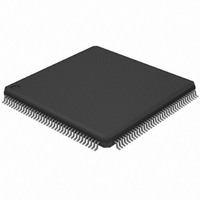AT32UC3A364-ALUT Atmel, AT32UC3A364-ALUT Datasheet - Page 97

AT32UC3A364-ALUT
Manufacturer Part Number
AT32UC3A364-ALUT
Description
IC MCU 64KB FLASH 144LQFP
Manufacturer
Atmel
Series
AVR®32 UC3r
Specifications of AT32UC3A364-ALUT
Core Processor
AVR
Core Size
32-Bit
Speed
66MHz
Connectivity
EBI/EMI, I²C, IrDA, MMC, SPI, SSC, UART/USART, USB OTG
Peripherals
Brown-out Detect/Reset, DMA, POR, WDT
Number Of I /o
110
Program Memory Size
64KB (64K x 8)
Program Memory Type
FLASH
Ram Size
128K x 8
Voltage - Supply (vcc/vdd)
1.65 V ~ 1.95 V
Data Converters
A/D 8x10b
Oscillator Type
Internal
Operating Temperature
-40°C ~ 85°C
Package / Case
144-LQFP
Processor Series
AT32UC3x
Core
AVR32
Data Bus Width
32 bit
Data Ram Size
96 KB
Interface Type
IrDA/SCI/SCIF/UDI
Maximum Clock Frequency
66 MHz
Number Of Timers
3
Operating Supply Voltage
3 V to 3.6 V
Maximum Operating Temperature
+ 85 C
Mounting Style
SMD/SMT
3rd Party Development Tools
EWAVR32, EWAVR32-BL, KSK-EVK1100-PL
Development Tools By Supplier
ATAVRDRAGON, ATSTK500, ATSTK600, ATAVRISP2, ATAVRONEKIT, ATEXTWIFI, ATEVK1104
Minimum Operating Temperature
- 40 C
Controller Family/series
AT32UC3A
No. Of I/o's
110
Ram Memory Size
64KB
Cpu Speed
66MHz
No. Of Timers
2
Rohs Compliant
Yes
For Use With
ATEVK1104 - KIT DEV/EVAL FOR AVR32 AT32UC3AATAVRONEKIT - KIT AVR/AVR32 DEBUGGER/PROGRMMRATEVK1100 - KIT DEV/EVAL FOR AVR32 AT32UC3A
Lead Free Status / RoHS Status
Lead free / RoHS Compliant
Eeprom Size
-
Lead Free Status / Rohs Status
Lead free / RoHS Compliant
Available stocks
Company
Part Number
Manufacturer
Quantity
Price
- Current page: 97 of 1014
- Download datasheet (16Mb)
10.5.1
10.5.2
10.5.3
32072C–AVR32–2010/03
Non-Maskable Interrupts
CPU Response
Clearing an Interrupt Request
Interrupt Priority Register (IPR). The GrpReq inputs are then masked by the mask bits from the
CPU status register. Any interrupt group that has a pending interrupt of a priority level that is not
masked by the CPU status register, gets its corresponding ValReq line asserted.
Masking of the interrupt requests is done based on five interrupt mask bits of the CPU status
register, namely Interrupt Level 3 Mask (I3M) to Interrupt Level 0 Mask (I0M), and Global Inter-
rupt Mask (GM). An interrupt request is masked if either the GM or the corresponding interrupt
level mask bit is set.
The Prioritizer hardware uses the ValReq lines and the INTLEVEL field in the IPRs to select the
pending interrupt of the highest priority. If an NMI interrupt request is pending, it automatically
gets the highest priority of any pending interrupt. If several interrupt groups of the highest pend-
ing interrupt level have pending interrupts, the interrupt group with the lowest number is
selected.
The INTLEVEL and handler autovector offset (AUTOVECTOR) of the selected interrupt are
transmitted to the CPU for interrupt handling and context switching. The CPU does not need to
know which interrupt is requesting handling, but only the level and the offset of the handler
address. The IRR registers contain the interrupt request lines of the groups and can be read via
user interface registers for checking which interrupts of the group are actually active.
The delay through the INTC from the peripheral interrupt request is set until the interrupt request
to the CPU is set is three cycles of CLK_SYNC.
A NMI request has priority over all other interrupt requests. NMI has a dedicated exception vec-
tor address defined by the AVR32 architecture, so AUTOVECTOR is undefined when
INTLEVEL indicates that an NMI is pending.
When the CPU receives an interrupt request it checks if any other exceptions are pending. If no
exceptions of higher priority are pending, interrupt handling is initiated. When initiating interrupt
handling, the corresponding interrupt mask bit is set automatically for this and lower levels in sta-
tus register. E.g, if an interrupt of level 3 is approved for handling, the interrupt mask bits I3M,
I2M, I1M, and I0M are set in status register. If an interrupt of level 1 is approved, the masking
bits I1M and I0M are set in status register. The handler address is calculated by logical OR of
the AUTOVECTOR to the CPU system register Exception Vector Base Address (EVBA). The
CPU will then jump to the calculated address and start executing the interrupt handler.
Setting the interrupt mask bits prevents the interrupts from the same and lower levels to be
passed through the interrupt controller. Setting of the same level mask bit prevents also multiple
requests of the same interrupt to happen.
It is the responsibility of the handler software to clear the interrupt request that caused the inter-
rupt before returning from the interrupt handler. If the conditions that caused the interrupt are not
cleared, the interrupt request remains active.
Clearing of the interrupt request is done by writing to registers in the corresponding peripheral
module, which then clears the corresponding NMIREQ/IREQ signal.
The recommended way of clearing an interrupt request is a store operation to the controlling
peripheral register, followed by a dummy load operation from the same register. This causes a
AT32UC3A3/A4
97
Related parts for AT32UC3A364-ALUT
Image
Part Number
Description
Manufacturer
Datasheet
Request
R

Part Number:
Description:
KIT DEV/EVAL FOR AT32UC3A3
Manufacturer:
Atmel
Datasheet:

Part Number:
Description:
DEV KIT FOR AVR/AVR32
Manufacturer:
Atmel
Datasheet:

Part Number:
Description:
INTERVAL AND WIPE/WASH WIPER CONTROL IC WITH DELAY
Manufacturer:
ATMEL Corporation
Datasheet:

Part Number:
Description:
Low-Voltage Voice-Switched IC for Hands-Free Operation
Manufacturer:
ATMEL Corporation
Datasheet:

Part Number:
Description:
MONOLITHIC INTEGRATED FEATUREPHONE CIRCUIT
Manufacturer:
ATMEL Corporation
Datasheet:

Part Number:
Description:
AM-FM Receiver IC U4255BM-M
Manufacturer:
ATMEL Corporation
Datasheet:

Part Number:
Description:
Monolithic Integrated Feature Phone Circuit
Manufacturer:
ATMEL Corporation
Datasheet:

Part Number:
Description:
Multistandard Video-IF and Quasi Parallel Sound Processing
Manufacturer:
ATMEL Corporation
Datasheet:

Part Number:
Description:
High-performance EE PLD
Manufacturer:
ATMEL Corporation
Datasheet:

Part Number:
Description:
8-bit Flash Microcontroller
Manufacturer:
ATMEL Corporation
Datasheet:

Part Number:
Description:
2-Wire Serial EEPROM
Manufacturer:
ATMEL Corporation
Datasheet:











